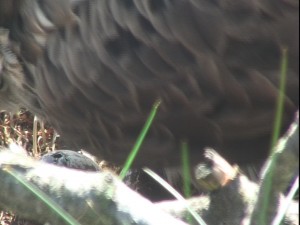Osprey Diary Thurs 23rd May
On the loch today, we have great news: one of our pair of Great Crested grebes have chosen to nest in the water lilies right opposite the hides again- they are making good progress and giving us fantastic views of their efforts. There are now also at least 7 Blue tit eggs in our nest camera box , on display live in the Visitor centre- due to hatch the first week of June. There has been a very large female osprey intruder around on the loch this afternoon, but nothing that upset our resident pair too much.
Osprey Q and A- remember of you can’t find the answer to your questions in our FAQ section at the top of this page, you can email it to: ospreys@swt.org.uk and the ranger will try to answer it here for all to share.
Q: When are the osprey eggs due?
A: Osprey incubation is usually 35-40 days with an average of 37days being pretty spot on. 37days for the first egg is the 25th May, for the 2nd egg the 28th , the 3rd the 31st and the 4th the 3rd June.
Q: How many of the four eggs do you think will hatch?
A: There is no way of knowing for sure- we will have to wait and see. Obviously we hope they all will, but given our females age, her lower success rate in recent years, and the recent incident where the male left the eggs uncovered for over an hour which may have damaged them, we need to prepare oursleves for the eventuality that the chances of four chicks are low. However, this female has a habit of surprising us so its just possible- personally I’d be very happy with one or two healthy chicks.
Q: What signs are we looking for as the eggs near hatching?
A:The female osprey will usually shuffle the eggs a lot as they near hatching and will tilt her head to the side and listen to the chicks making tiny sounds inside the eggs.
The eggs themselves may move a tiny amount as the chicks inside shift position.
The process of any bird hatching begins with the chick inside using a tiny spike on its beak called an ‘egg tooth’ to break a wee small hole in the shell. This lets in oxygen and allows the membrane joining the chick to the shell to dry out gradually. This tiny hole is about 2-3mm across- every time the eggs are uncovered will we be looking for these on the eggs. Sometimes grass, fish scales and even raindrops can be mistaken for holes or cracks, so will need to be looking very carefully. After this, tiny cracks then appear in the egg shell, but it can take up to 12hours for the chick to emerge completely. The female will then remove the broken shell to the outer nest.
Q: Why has the nest got so much grass growing in it this year?
A: We are not sure why the female did not remove as much grass this year as previously- she seemed to concentrate on the very centre of the nest and lining it extra well with moss etc ( perhaps because of the cold). The male also doesn’t seem to have brought in quite so many new sticks to add to the sides as last year when he was initially bonding with his new mate- but there is still time yet for him to add to it as the chicks grow.
Q: Is the male putting grass and sticks on his own back whilst incubating to act as camouflage?
A: This is a good suggestion for a behaviour we have otherwise no real explanation for it at the moment- the other possibility is it is what is known as ‘displacement behaviour’ or fidgeting!
Q: How did you tell how many eggs or chicks there were in a nest before nest cameras?
A: Behavioural changes are the only way to tell what is happening on an osprey nest from a safe distance. When one of the parents begins to sit on the nest at all times, snuggled down low in the centre, not standing around on the edge, and when a fish is delivered , there will be a change over where the bird about to sit can often be seen looking into the nest centre and walking more carefully, we know there are eggs being incubated.
Eggs hatching can be spotted by lots of shuffling by the parents and egg shell being thrown over the edge, and then when a fish is delivered, it won’t be taken away from the nest as usual, but kept and shredded on the spot. The parent bird will reach into the nest centre with food in its beak . Even if you can’t see the chick yet, this confirms the presence of at least one chick in the nest.
The number of chicks has to wait until they are 2-3 weeks old and big enough to see the heads above the nest rim at feeding times- then count the heads!
Ranger Emma
Help protect Scotland’s wildlife
Our work to save Scotland’s wildlife is made possible thanks to the generosity of our members and supporters.
Join today from just £3 a month to help protect the species you love.
Preface
On the loch today, we have great news: one of our pair of Great Crested grebes have chosen to nest in the water lilies right opposite the hides again- they …

